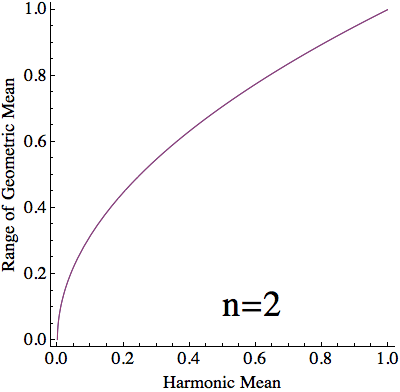One way to look at this problem is to look for the extremes of the geometric mean given fixed arithmetic and harmonic means.
The following inequalities can be verified by taking $\log$s and using Jensen:
$$
\frac{1}{\int\frac{1}{x}\;\mathrm{d}\mu}\le\exp\left(\int\log(x)\;\mathrm{d}\mu\right)\le\int x\;\mathrm{d}\mu\tag{1}
$$
That is, $HM\le GM\le AM$.
Scaling the data scales all three means by the same factor, so let us assume that
$$
\int x\;\mathrm{d}\mu=1\quad\text{(arithmetic mean }=1\text{)}\tag{2}
$$
and
$$
\int\frac{\mathrm{d}\mu}{x}=\frac{1}{h}\quad\text{(harmonic mean }=h\text{)}\tag{3}
$$
and attempt to find the critical values for the $\log$ of the geometric mean:
$$
\int\log(x)\;\mathrm{d}\mu\tag{4}
$$
Taking variances of $(2)$, $(3)$, and $(4)$, we get that for all variations so that the $AM$ is stationary
$$
\int\delta x\;\mathrm{d}\mu=0\tag{5}
$$
and the reciprocal of the $HM$ is stationary,
$$
\int\frac{\delta x}{x^2}\mathrm{d}\mu=0\tag{6}
$$
we should also have that the $\log$ of the geometric mean is stationary:
$$
\int\frac{\delta x}{x}\mathrm{d}\mu=0\tag{7}
$$
Linearity considerations say that $(5)$, $(6)$, and $(7)$ imply that there are constants $a$ and $b$ so that
$$
\frac{1}{x}=a+\frac{b}{x^2}\tag{8}
$$
Multiplying $(8)$ by x and combining with $(2)$ and $(3)$ yields
$$
1=a+\frac{b}{h}\tag{9}
$$
Solving $(8)$ for $x$ and $(9)$ for $b$, we get
$$
x=\frac{1\pm\sqrt{1-4ha(1-a)}}{2a}\tag{10}
$$
To maintain $(2)$, we need a combination of the two values of $x$:
$$
\lambda\frac{1+\sqrt{1-4ha(1-a)}}{2a}+(1-\lambda)\frac{1-\sqrt{1-4ha(1-a)}}{2a}=1\tag{11}
$$
Solving $(11)$ for $\lambda$, we get
$$
\lambda=\frac{1}{2}\left(1+\frac{2a-1}{\sqrt{1-4ha(1-a)}}\right)\quad\text{and}\quad a=\frac{1}{2}\left(1+\frac{2\lambda-1}{\sqrt{1+4\frac{h}{1-h}\lambda(1-\lambda)}}\right)\tag{12}
$$
Note that $(12)$ shows that $\lim\limits_{a\to0}\frac{\lambda}{a}=\lim\limits_{a\to1}\frac{1-\lambda}{1-a}=1$.
For a given harmonic mean, $h$, and split between values of $x$, $\lambda$, $(10)$ and $(12)$ yield that the stationary geometric mean is
$$
\begin{align}
g(h,\lambda)
&=\left(\frac{1+\sqrt{1-4ha(1-a)}}{2a}\right)^\lambda\left(\frac{1-\sqrt{1-4ha(1-a)}}{2a}\right)^{1-\lambda}\\
&=\frac{\left(\sqrt{1+4\frac{h}{1-h}\lambda(1-\lambda)}+1\right)^\lambda\left(\sqrt{1+4\frac{h}{1-h}\lambda(1-\lambda)}-1\right)^{1-\lambda}}{\sqrt{1+4\frac{h}{1-h}\lambda(1-\lambda)}+2\lambda-1}\tag{13}
\end{align}
$$
For each $h\in[0,1]$, $g(h,\lambda)$ is monotonic in $\lambda$ (verified below) and
$$
\lim_{\lambda\to0}g(h,\lambda)=h\qquad\text{and}\qquad\lim_{\lambda\to1}g(h,\lambda)=1\tag{14}
$$
With a countinuous selection of $\lambda$, we can attain any value of $g(h,\lambda)$ between $h$ and $1$. However, When dealing with $n$ numbers, $\lambda$ can only take the values $\frac{1}{n}\dots \frac{n-1}{n}$. Thus, with a harmonic mean of $h$, the geometric mean can only vary between $g(h,\frac{1}{n})$ and $g(h,\frac{n-1}{n})$.
$\mathbf{n}$ objects with arithmetic mean $\mathbf{=1}$:

Proof that for any $\mathbf{h}$, $\mathbf{g(h,\lambda)}$ is monotonic in $\mathbf{\lambda}$:
Fix $h$. Define
$$
\Delta=\sqrt{1+4\frac{h}{1-h}\lambda(1-\lambda)}\tag{15}
$$
Using $(13)$ and $(15)$, we get that
$$
g(h,\lambda)=\frac{(\Delta+1)^\lambda(\Delta-1)^{1-\lambda}}{\Delta+2\lambda-1}\tag{16}
$$
Equation $(15)$ also implies that
$$
(1-h)\Delta^2+h(2\lambda-1)^2=1\tag{17}
$$
In consideration of $(17)$, define $\eta$ and $\theta$ by
$$
\begin{align}
\sin(\eta)&=\sqrt{h}\\
\cos(\eta)&=\sqrt{1-h}
\end{align}\tag{18}
$$
and
$$
\begin{align}
\sin(\theta)&=\sin(\eta)\;(2\lambda-1)\\
\cos(\theta)&=\cos(\eta)\;\Delta
\end{align}\tag{19}
$$
where $0\le\lambda\le1$ and thus $-\eta\le\theta\le\eta$. Then using the identities
$$
\begin{array}{ccccc}
\cos(\eta)(\Delta+1)&=&\cos(\theta)+\cos(\eta)&=&2\cos\left(\frac{\eta+\theta}{2}\right)\cos\left(\frac{\eta-\theta}{2}\right)\\
\cos(\eta)(\Delta-1)&=&\cos(\theta)-\cos(\eta)&=&2\sin\left(\frac{\eta+\theta}{2}\right)\sin\left(\frac{\eta-\theta}{2}\right)\\
\sin(\eta)2\lambda&=&\sin(\eta)+\sin(\theta)&=&2\sin\left(\frac{\eta+\theta}{2}\right)\cos\left(\frac{\eta-\theta}{2}\right)\\
\sin(\eta)2(1-\lambda)&=&\sin(\eta)-\sin(\theta)&=&2\cos\left(\frac{\eta+\theta}{2}\right)\sin\left(\frac{\eta-\theta}{2}\right)
\end{array}\tag{20}
$$
we get that
$$
\begin{align}
&\left(\frac{1}{\sin(\eta)}\frac{(\Delta+1)^\lambda(\Delta-1)^{1-\lambda}}{\Delta+2\lambda-1}\right)^{2\sin(\eta)}\\
&\vphantom{\Huge{\dfrac{A}{A}}}=\frac{(\cos(\theta)+\cos(\eta))^{\sin(\eta)+\sin(\theta)}(\cos(\theta)-\cos(\eta))^{\sin(\eta)-\sin(\theta)}}{\left(\sin(\eta)\cos(\theta)+\cos(\eta)\sin(\theta)\right)^{2\sin(\eta)}}\\
&\vphantom{\Huge{\dfrac{A}{A}}}=\frac{(2\cos(\frac{\eta+\theta}{2})\cos(\frac{\eta-\theta}{2}))^{\sin(\eta)+\sin(\theta)}(2\sin(\frac{\eta+\theta}{2})\sin(\frac{\eta-\theta}{2}))^{\sin(\eta)-\sin(\theta)}}{\sin(\eta+\theta)^{2\sin(\eta)}}\\
&\vphantom{\Huge{\dfrac{A}{A}}}=\frac{(\sin(\eta+\theta)\sin(\eta-\theta))^{\sin(\eta)}(\cot(\frac{\eta+\theta}{2})\cot(\frac{\eta-\theta}{2}))^{\sin(\theta)}}{\sin(\eta+\theta)^{2\sin(\eta)}}\\
&\vphantom{\Huge{\dfrac{A}{A}}}=\left(\frac{\sin(\eta-\theta)}{\sin(\eta+\theta)}\right)^{\sin(\eta)}\left(\frac{\cos(\theta)+\cos(\eta)}{\cos(\theta)-\cos(\eta)}\right)^{\sin(\theta)}\tag{21}
\end{align}
$$
The logarithmic derivative of $(21)$ is
$$
\begin{align}
&\frac{\mathrm{d}}{\mathrm{d}\theta}\left(\sin(\eta)\log\left(\frac{\sin(\eta-\theta)}{\sin(\eta+\theta)}\right)+\sin(\theta)\log\left(\frac{\cos(\theta)+\cos(\eta)}{\cos(\theta)-\cos(\eta)}\right)\right)\\
&\vphantom{\Huge{A}}=\sin(\eta)(-\cot(\eta-\theta)-\cot(\eta+\theta))\\
&+\cos(\theta)\log\left(\frac{\cos(\theta)+\cos(\eta)}{\cos(\theta)-\cos(\eta)}\right)\\
&+\sin(\theta)\left(\frac{-\sin(\theta)}{\cos(\theta)+\cos(\eta)}+\frac{\sin(\theta)}{\cos(\theta)-\cos(\eta)}\right)\\
&\vphantom{\Huge{\dfrac{A}{A}}}=-2\cos(\eta)+\cos(\theta)\log\left(\frac{\cos(\theta)+\cos(\eta)}{\cos(\theta)-\cos(\eta)}\right)\tag{22}
\end{align}
$$
Dividing $(22)$ by $\cos(\theta)$ and setting $t=\dfrac{\cos(\eta)}{\cos(\theta)}$, yields that $(22)$ vanishes precisely when
$$
-2t+\log\left(\frac{1+t}{1-t}\right)=0\tag{23}
$$
However, $(23)$ vanishes only at $t=0$, but because $-\eta\le\theta\le\eta$, we have $t\ge\cos(\eta)=\sqrt{1-h}$. Therefore, $(22)$ doesn't vanish, and thus, $(21)$ is monotonic.
When $\theta$ is such that $r=6\cos(\theta)$ is positive, as you know, we go to the ray of angle $\theta$ counterclockwise from the positive $x$-axis, and we mark a point distance $r$ from the origin on this ray. This is moving in the "positive" direction along that ray.
When $\theta$ is such that $r=6\cos(\theta)$ is negative, we again find the ray of angle $\theta$ counterclockwise from the positive $x$-axis, but we want to mark a point distance $|r|$ from the origin in the negative direction on that ray. This means instead of moving in the direction the ray points, we move the opposite direction (i.e., the positive direction on the ray of angle $\theta + \pi$). This is why in the second picture, instead of getting points in the second quadrant, they end up in the fourth quadrant.

Best Answer
There are $51$ zeros of the polynomial, leaving $52$ continuous segments where the polynomial is either always positive or always negative. Hence there are $26$ positive and negative segments each; the rightmost such segment must be positive since the leading coefficient is positive, and contains $249-201+1=49$ numbers. The other $25$ positive segments each contain a single integer each, as is easy to see; the polynomial's degree is odd, so the large leftmost segment is negative. This gives the final answer as $49+25=74$.